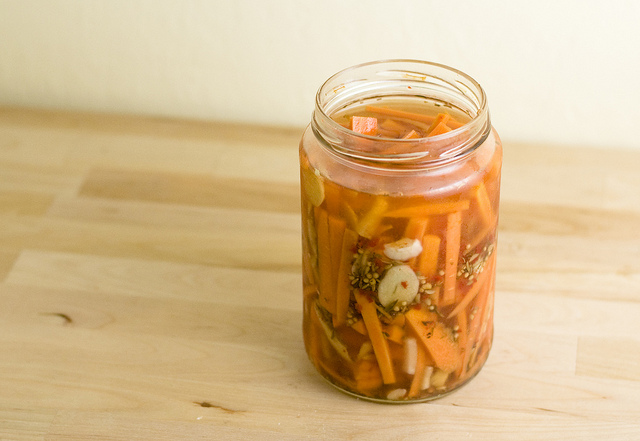Cultured Foods: Fermented Dilly Carrot Sticks
Lacto-fermented foods, also known as cultured foods, are rich in probiotics that help balance the intestinal flora. This in turn allows food to digest better and our bodies to absorb the nutrients more completely. The following is a quote from Nourishing Traditions, by Sally Fallon. “The proliferation of lactobacilli in fermented vegetables enhances their digestibility and increases vitamin levels. These beneficial organisms produce numerous helpful enzymes as well as antibiotic and anticarcinogenic substances. Their main by-product, lactic acid, not only keeps vegetables and fruits in a state of perfect preservation but also promotes the growth of healthy flora throughout the intestine.” If you’d like to try adding cultured foods to your diet, here’s an easy and delicious recipe to start with. See notes below on making your own whey and a dairy-free alternative. Dilly Carrot Sticks
Place carrot sticks into a quart mason jar and add the rest of the ingredients, shaking gently to settle the carrots if needed. Fill to within one inch of the top with filtered water. Cover tightly and allow to sit at room temperature for 4-7 days; taste them at 4 days. If you want them to be softer or more sour, leave them longer. Because carrots are denser than other foods, they take longer to ferment. They also stay crunchier, which is a nice change of pace to most lacto-fermented foods. After they have fermented at room temperature, keep in your fridge; they will last for months! To make your own whey (and cream cheese): Line a drip coffee maker’s filter container with a paper filter. Place up to 3 cups whole milk yogurt into the container. The whey will drain into the coffee carafe. Leave the maker on the counter or put the whole maker into the fridge during this process. Once the whey has finished draining, about 12-14 hours, remove the cream cheese from the filter, dispose of the filter, and put the collected cream cheese and whey into separate glass containers. Store in the refrigerator. A note about whey and dairy: You can make lacto-fermented foods without using whey if you prefer a dairy-free alternative. Omit the whey and use two tablespoons of sea salt instead.
top | Newsletter Home | Article Index | Archive
|



